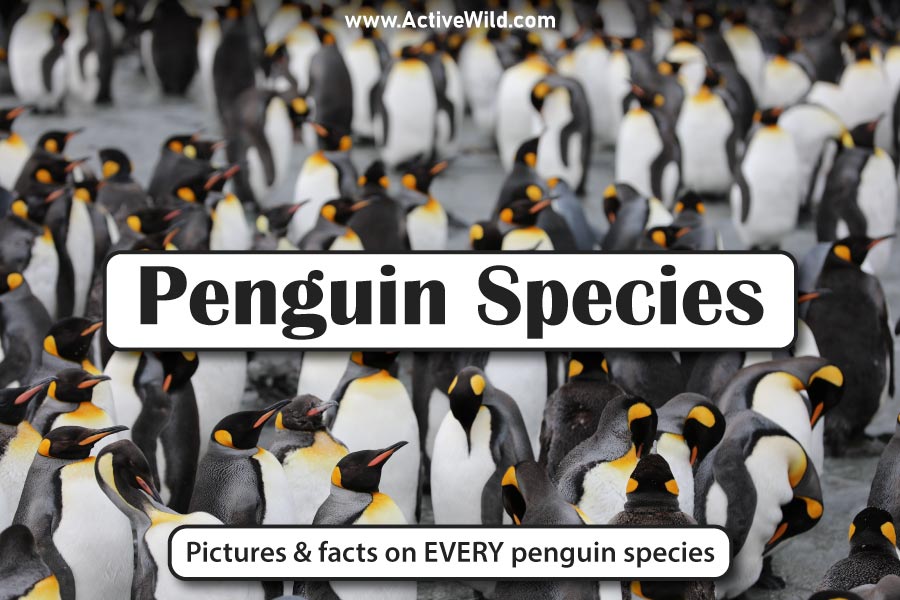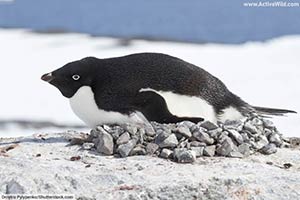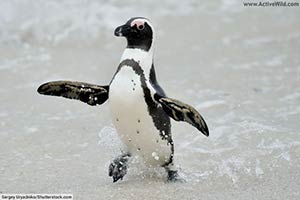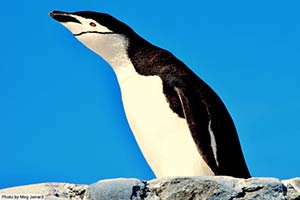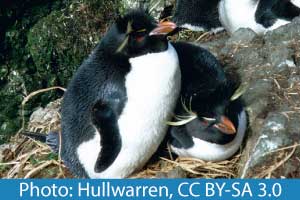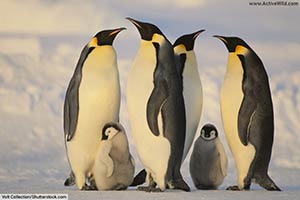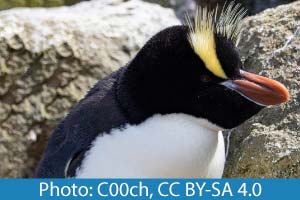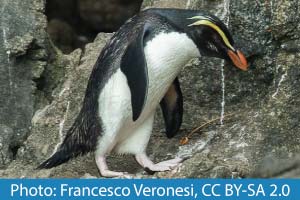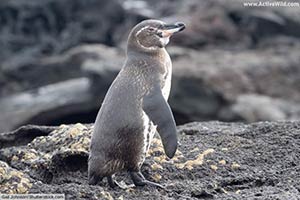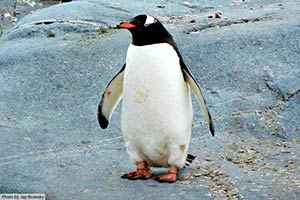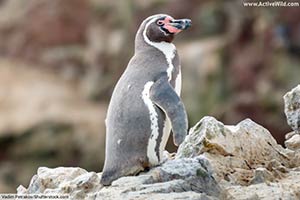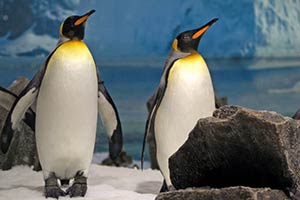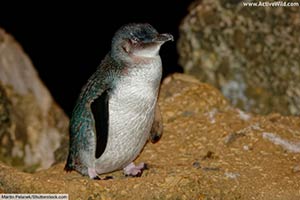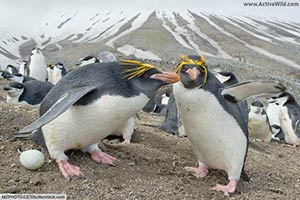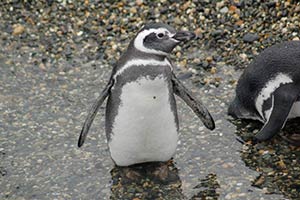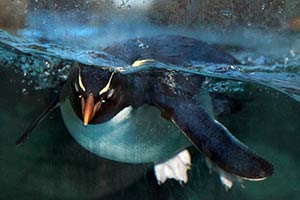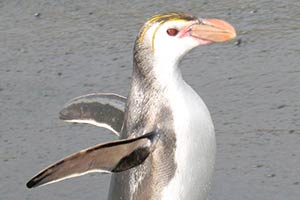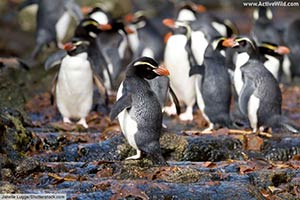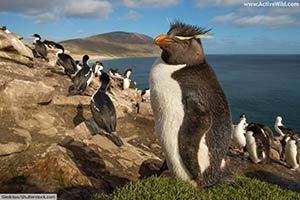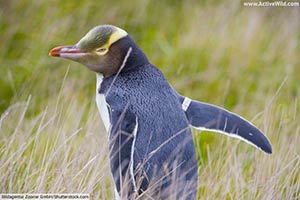Information, pictures and facts on every living penguin species.
Types of Penguins
Well-known types of penguin include the emperor penguin (the world's largest penguin) and its close cousin the king penguin; the macaroni penguin (the world's most common penguin); the chinstrap penguin (the most common penguin species in Antarctica); the little penguin (the smallest penguin); the African penguin (a species found on the coasts of Southern Africa); and the Galápagos penguin, which is found further north than any other type of penguin.
On this page is a list of all living penguin species, with pictures and facts on each. Test your penguin knowledge with a FREE printable penguin worksheet!
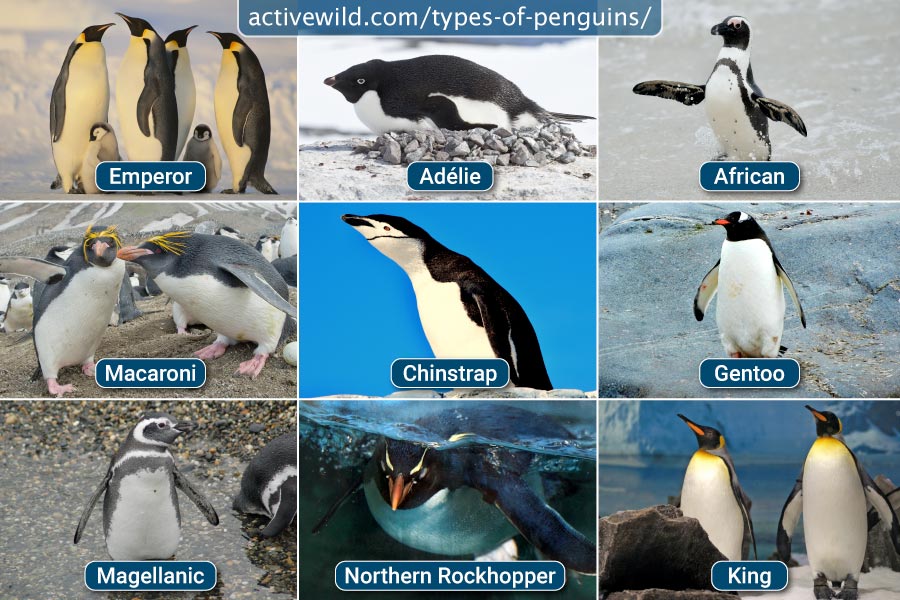
Free Printable Penguin Worksheet
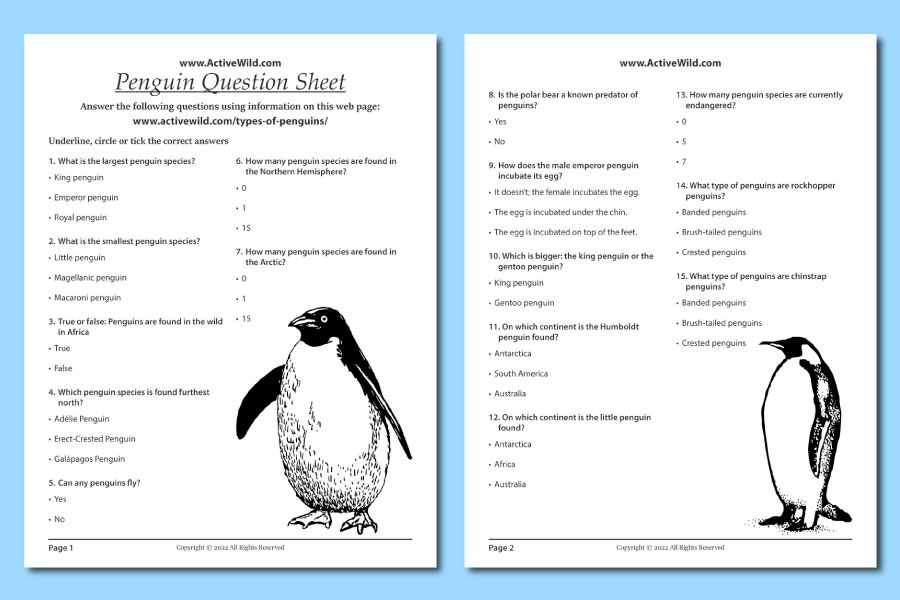
What Is A Penguin?
Penguins are aquatic, flightless seabirds in the family Spheniscidae. Although penguins have lost the ability to fly, they are skilled swimmers. A penguin's powerful wings are adapted for "flying" through the water rather than through the air.
The black and white coloration of penguins is an example of "countershading" – a means of camouflage that conceals an animal from both above and below. (While a penguin is swimming, its pale undersides conceal it against the sky, while its dark back conceals it against the sea bed.)
Penguins hunt at sea, using their excellent swimming abilities to capture their prey, which includes ocean animals such as krill, fish and squid. Predators of penguins include sharks, killer whales (orcas) and leopard seals.
Although many penguins live on cold, inhospitable Antarctic and subantarctic coastlines, some penguin species are found in temperate regions further north.
- You can find out more about penguins that live on Antarctica on this page: Antarctic Penguins
Only one penguin species, the Galápagos penguin, is found in the Northern Hemisphere. (The Galápagos penguin is found on the Galápagos Islands, which straddle the Equator. The Galápagos penguin is therefore found in both the Southern and Northern Hemispheres.)
Penguins are not found in the Arctic, and a penguin will therefore never meet a polar bear in the wild!
- You can find out more about penguins on this page: Penguin Facts
Penguin Species Index
Click on a photo below to find information on a particular species, or continue scrolling to browse all of the penguins.
- On this page you'll find pictures and facts on all 19 living penguin species currently listed in the Catalogue of Life (source, January 2022).
- Sadly, several types of penguins are endangered. In the list below we've included the conservation status of each species, using data from the IUCN Red List (source, January 2022).
At the bottom of the page is a "Penguin Species Chart". You can use the sortable columns of this chart to list penguin species by genus, weight, height, endangered status, etc. Click here to go to the chart
How Many Different Types Of Penguins Are There?
In total, there are around nineteen different types of penguins. The exact number of penguin species is disputed because some penguins are very closely related to others, making classification difficult.
(While some biologists may regard two closely-related penguins as being separate species, others regard them as being the same species.)
For example, the three rockhopper penguin species on the list below are considered by some biologists to be a single species, while others consider the eastern and southern rockhopper to be a single species, separate to the northern rockhopper. In other words, there are either three, two or just one species of rockhopper penguin!
On this page, we've included all of the penguins currently listed in the Catalogue of Life, a global database of species.
- For information on how animals are classified, visit this page: Animal Classification.
Related Pages on Active Wild
- You can find out more about penguins here: Penguin Facts
- Are penguins birds? Find out on this page: Are Penguins Birds... And Why?
- Discover which types of penguin live on Antarctica: Antarctic Penguins
- Become a bird expert! Visit this page: Birds: The Ultimate Guide
- Find out about Antarctica – home to several of the penguin species featured in this list: Antarctica Facts
Penguin Species List
Adélie Penguin
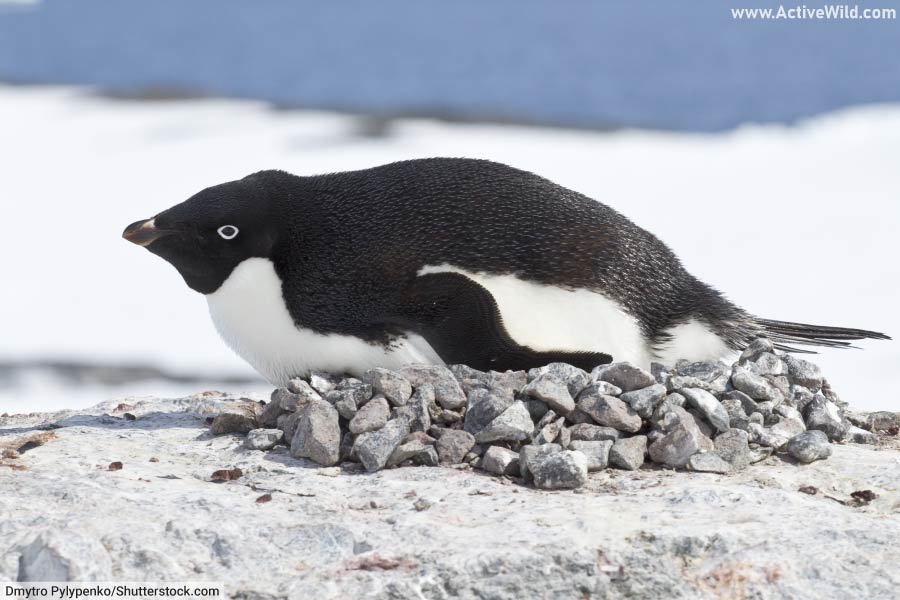
- Scientific name: Pygoscelis adeliae
- Type: Brush-Tailed Penguin
- Max weight: 6 kg / 13.2 lb
- Max height: 71 cm / 28 in
- Conservation status: Least Concern
- Population change: Increasing
The Adélie penguin is a medium-sized Antarctic penguin that can be recognized by the distinctive white ring around its eyes, and by the short black feathers that cover much of its bill.
The species is found all around the coast of Antarctica, and, along with the emperor penguin, lives further south than all other penguins.
The Antarctic krill, a crustacean that is abundant in Antarctic waters, forms the bulk of the Adélie penguin's diet.
The Adélie penguin was named after Adélie Land, a region of Antarctica that was itself named after the wife of French explorer Jules Dumont d'Urville. Dumont d'Urville also discovered the Adélie penguin.
- You can find out more about the Adélie penguin on this page: Adélie penguin Facts
African Penguin
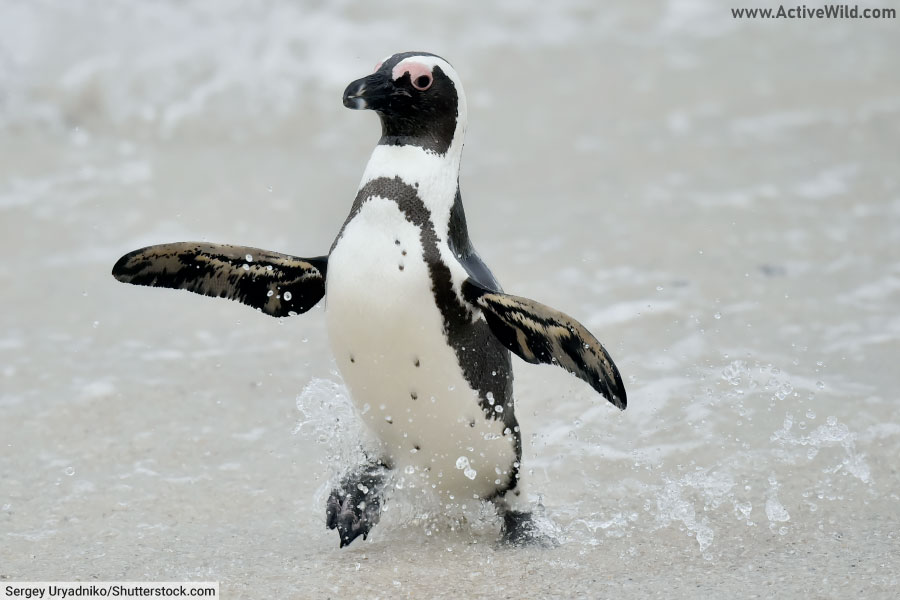
- Scientific name: Spheniscus demersus
- Other names: Jackass Penguin
- Scientific name: Spheniscus demersus
- Type: Banded Penguin
- Max weight: 3.5 kg / 7.7 lb
- Max height: 70 cm / 28 in
- Conservation status: Endangered
- Population change: Decreasing
The African penguin is found on islands lying off the south-western coast of Africa, as well as in scattered locations on the African mainland itself. (Two such breeding colonies are located near Cape Town in South Africa.)
The African penguin is a relatively small type of penguin. It has a black face and bill and, like all banded penguins, an "n-shaped" black band on its chest.
Above each of the African penguin’s eyes is a pink gland. This is an adaption to assist with thermoregulation (the process of keeping the body at the correct temperature). Blood flowing close to this area of skin is cooled by the air, thereby lowering the penguin’s body temperature.
The African penguin is also known as the "jackass penguin" due to the donkey-like sound of its calls.
Chinstrap Penguin
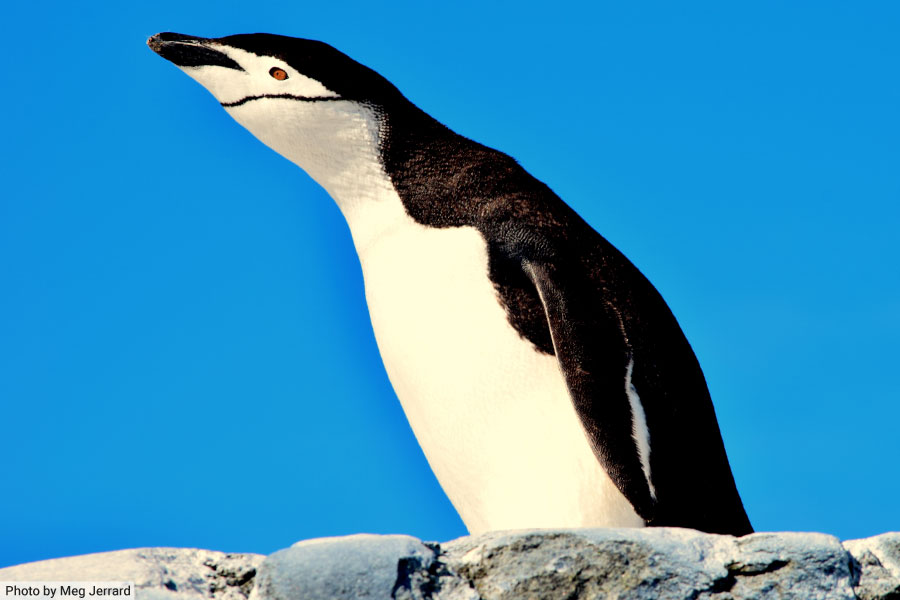
- Scientific name: Pygoscelis antarcticus
- Type: Brush-Tailed Penguin
- Max weight: 5 kg / 11 lb
- Max height: 72 cm / 28 in
- Conservation status: Least Concern
- Population change: Decreasing
The chinstrap penguin is a mid-sized penguin easily identified by the narrow black strip running along its chin. (It is this feature that gives the species its name.) Other distinguishing features include yellow-brown eyes, and a black ‘cap’ and bill.
The chinstrap penguin is found in many locations in the Southern, southern Pacific and Atlantic Oceans. Areas in which it is found include the Falkland Islands, Argentina, Chile and Antarctica. It is the most abundant penguin on the continent of Antarctica.
The diet of the chinstrap penguin consists of fish, shrimp and squid. The species will swim 50 miles / 80 km out to see in a single day when hunting.
Between 5 and 20% of all chinstrap penguins are predated by leopard seals each year.
Eastern Rockhopper Penguin
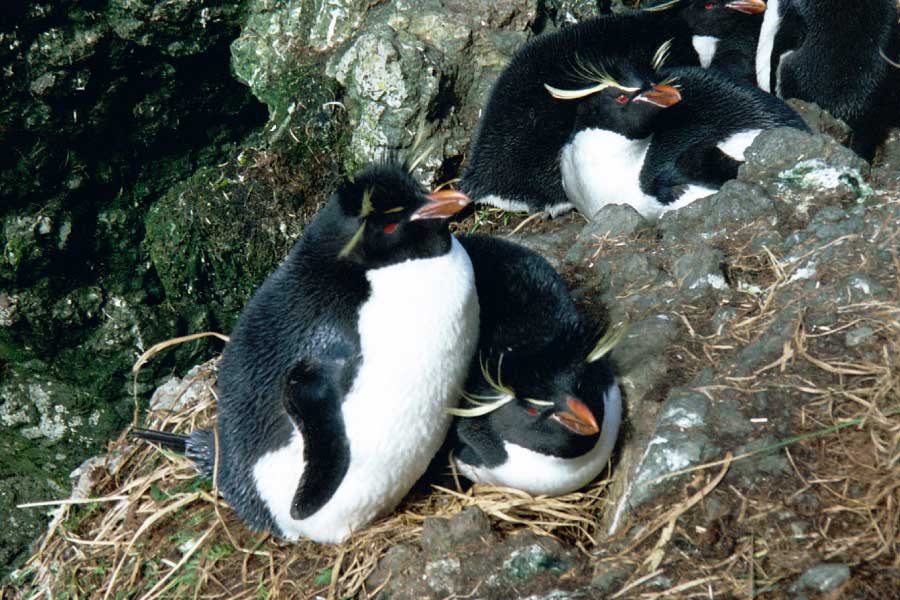
- Scientific name: Eudyptes filholi
- Type: Crested Penguin
- Max weight: 4.5 kg / 10 lb
- Max height: 56 cm / 22 in
- Conservation status: Unassessed
- Population change: Unassessed
The eastern rockhopper penguin is a crested penguin found on several islands in the sub-Antarctic regions of the Indian and Pacific Oceans, including Prince Edward, Crozet and Kerguelen Islands.
The species spends much of its life at sea, only returning to land to breed and molt.
Many biologists consider the eastern rockhopper penguin be a subspecies of southern rockhopper penguin rather than a separate species.
Emperor Penguin
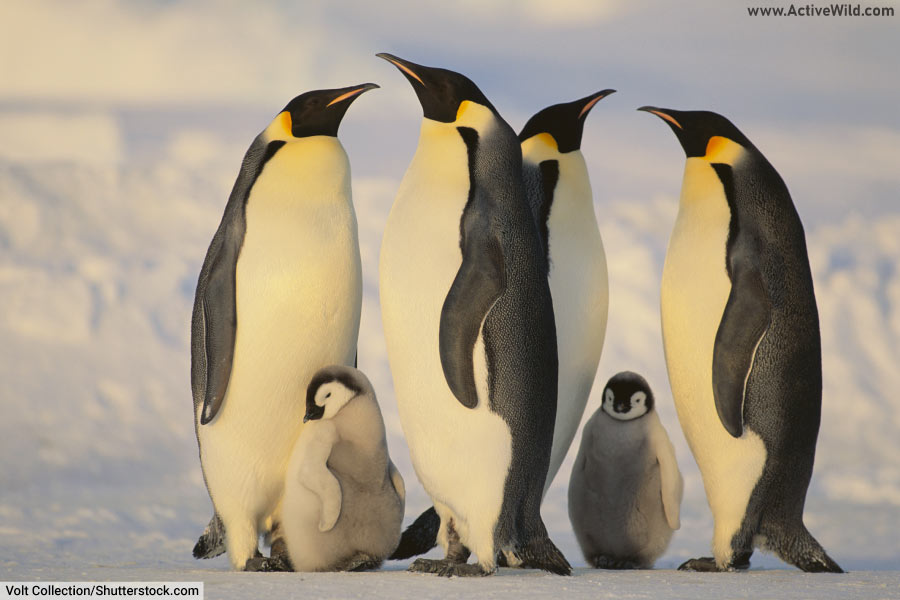
Emperor Penguin
- Scientific name: Aptenodytes forsteri
- Type: Great Penguin
- Max weight: 45.4 kg / 100 lb
- Max height: 130 cm / 51 in
- Conservation status: Near Threatened
- Population change: Decreasing
The emperor penguin is not only the largest type of penguin, being both the heaviest and the tallest member of the family Spheniscidae, but also the fifth-largest of all birds.
In addition to its large size, the emperor penguin's distinguishing features include orange-yellow feathers around its ears and shoulders, and the orange-pink color of its lower bill.
The emperor penguin is closely related to the king penguin; the two species are the only living members of the "great penguin" genus, Aptenodytes.
The emperor penguin is found only on the continent of Antarctica. Unlike all other penguins, it breeds during the Antarctic winter.
The species' eggs are incubated by the males, who huddle together in large groups for warmth. During this time, the egg is held on the top of the male's feet to keep it warm.
- You can find out more about the emperor penguin on this page: Emperor Penguin Facts
Erect-Crested Penguin
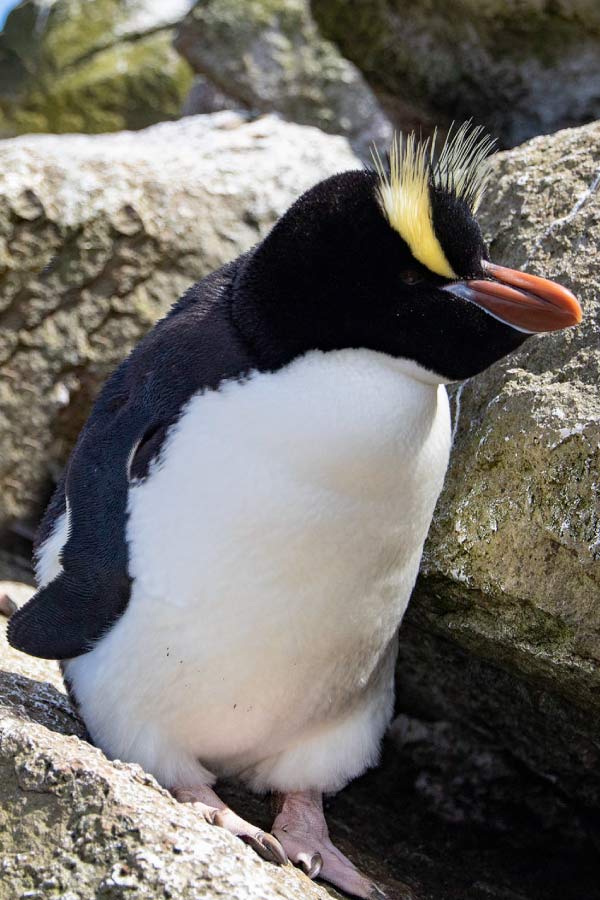
- Scientific name: Eudyptes sclateri
- Type: Crested Penguin
- Max weight: 6 kg / 13.2 lb
- Max height: 70 cm / 28 in
- Conservation status: Endangered
- Population change: Decreasing
The erect-crested penguin is found on New Zealand's Bounty and Antipodes Islands. It is a medium-sized penguin that, like all crested penguins, has a yellow crest that extends from its bill to the back of its head.
The erect-crested penguin is said to be the only crested penguin able to raise and lower its crest.
The erect-crested penguin is an endangered species. The population of mature erect-crested penguins is estimated to consist of around 150,000 individuals, and is thought to be declining, possibly due to the fishing industry.
Fiordland Penguin
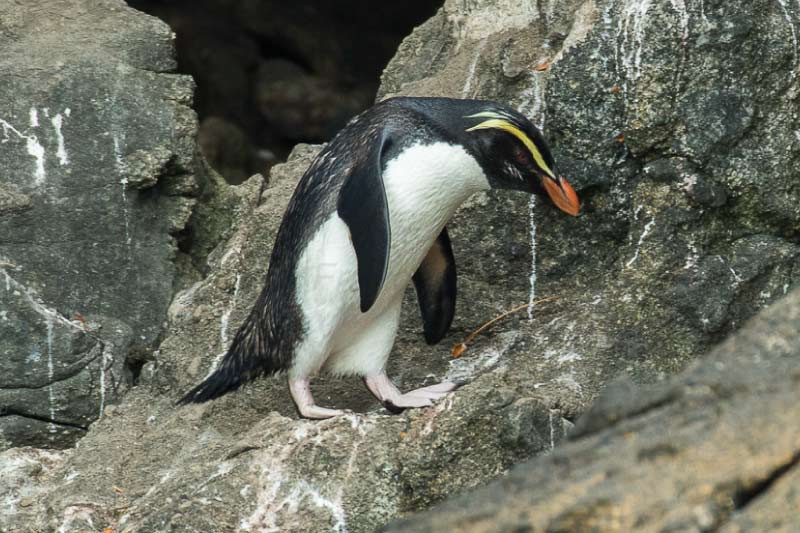
- Other names: Fiordland Crested Penguin
- Scientific name: Eudyptes pachyrhynchus
- Type: Crested Penguin
- Max weight: 5.95 kg / 13.1 lb
- Max height: 60 cm / 24 in
- Conservation status: Near Threatened
- Population change: Decreasing
The Fiordland penguin is a mid-sized species belonging to the genus Eudyptes, a group of penguins known as "crested penguins" due to their yellow feather crests. It breeds on the coasts of New Zealand's South and Stewart Islands, and on several neighboring islands. The Fiordland penguin is named after the Fiordland region of New Zealand's South Island.
Unlike the closely-related erect-crested and Snares penguins, the Fiordland penguin lacks an area of bare skin at the base of its bill.
Outside of the breeding season, the Fiordland penguin travels far and wide. It is known to travel up to 3,000 km / 1,864 miles southwest of New Zealand's South Island, and is also often seen on Tasmania, and occasionally on mainland Australia.
Galápagos Penguin
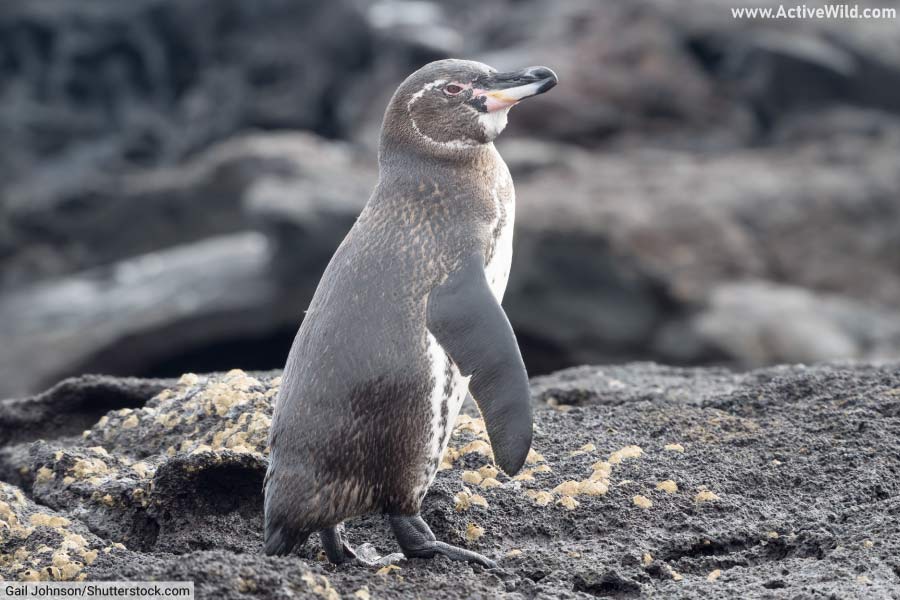
- Scientific name: Spheniscus mendiculus
- Type: Banded Penguin
- Max weight: 2.5 kg / 5.5 lb
- Max height: 49 cm / 19 in
- Conservation status: Endangered
- Population change: Decreasing
The Galápagos penguin is only found on the Galápagos Islands – a group of islands in the Pacific Ocean famous for providing the inspiration for Charles Darwin's Theory of Evolution.
The Galápagos Islands lie on the Equator, thereby making the Galápagos penguin the only penguin found in the northern hemisphere.
The Galápagos penguin is the second-smallest type of penguin (only the little penguin is smaller). It has a black face ringed by a narrow white line. Surrounding its white chest is a black band – a feature shared by all four banded penguins.
Gentoo Penguin
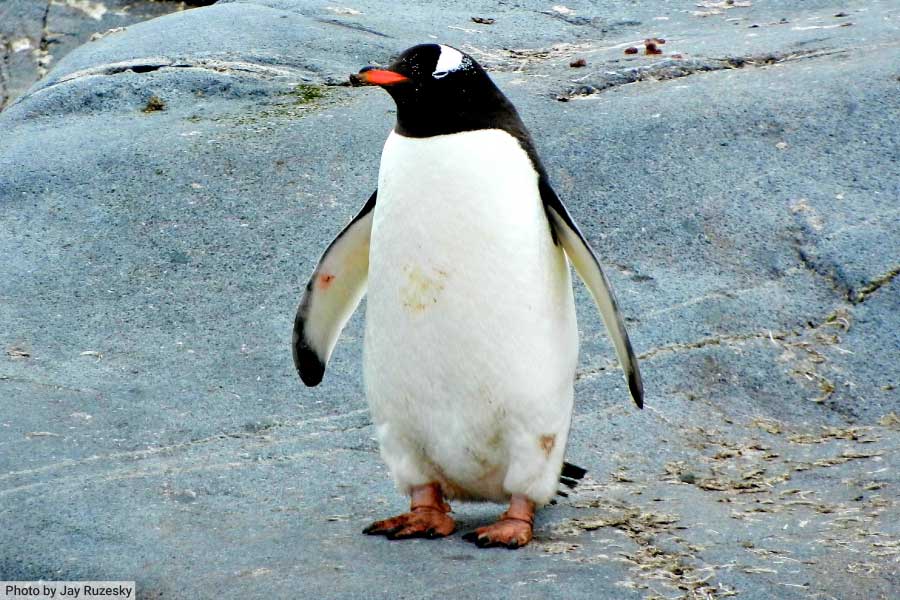
- Scientific name: Pygoscelis papua
- Type: Brush-Tailed Penguin
- Max weight: 8.5 kg / 19 lb
- Max height: 90 cm / 35 in
- Conservation status: Least Concern
- Population change: Stable
The Gentoo penguin is the third-largest species of penguin. It can be identified by the distinctive white stripe that runs from eye to eye over the top of the head. Other distinguishing features include a bright orange bill and orange feet.
The Gentoo penguin is found on several island groups in the sub-Antarctic region, including the Falkland Islands and South Georgia in the southern Atlantic Ocean, and the Kerguelen Islands (also known as the Desolation Islands) in the southern Indian Ocean.
The Gentoo penguin’s closest relative is the Adélie penguin.
Humboldt Penguin
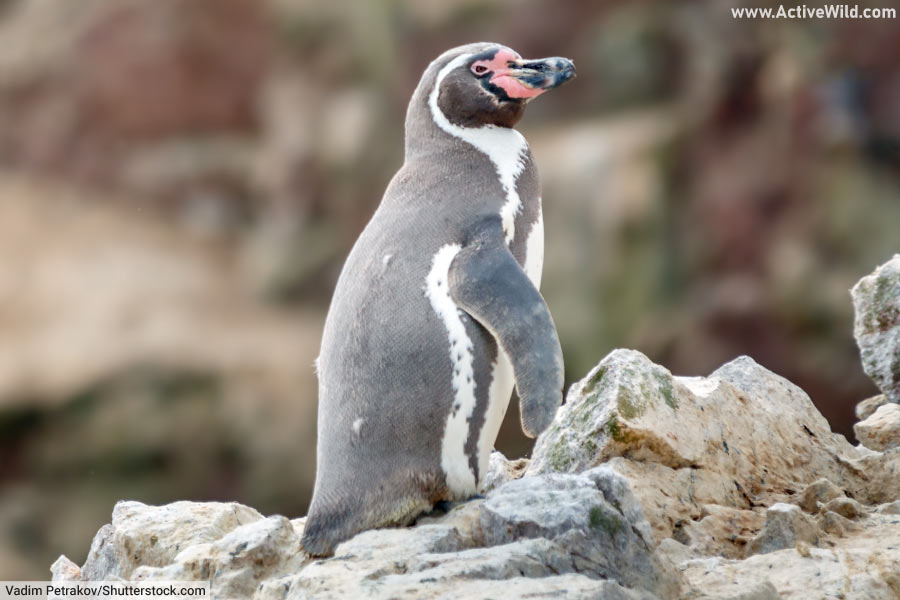
- Scientific name: Spheniscus humboldti
- Type: Banded Penguin
- Max weight: 5.9 kg / 13 lb
- Max height: 70 cm / 28 in
- Conservation status: Vulnerable
- Population change: Decreasing
The Humboldt penguin is a medium-sized penguin found on the western coast of South America. Like all four banded penguins of genus Spheniscus, the Humboldt penguin’s white chest is surrounded by a black band. At the base of its bill is a patch of fleshy pink skin.
A South American species, the Humboldt penguin is found on the coasts of Chile and Peru. It is occasionally also seen further north in Ecuador and Columbia.
The Humboldt penguin takes its name from the Humboldt Current, a current of cold water that flows northwards along the western coast of South America. The Humboldt Current itself was discovered by the Prussian naturalist and explorer Alexander von Humboldt.
King Penguin
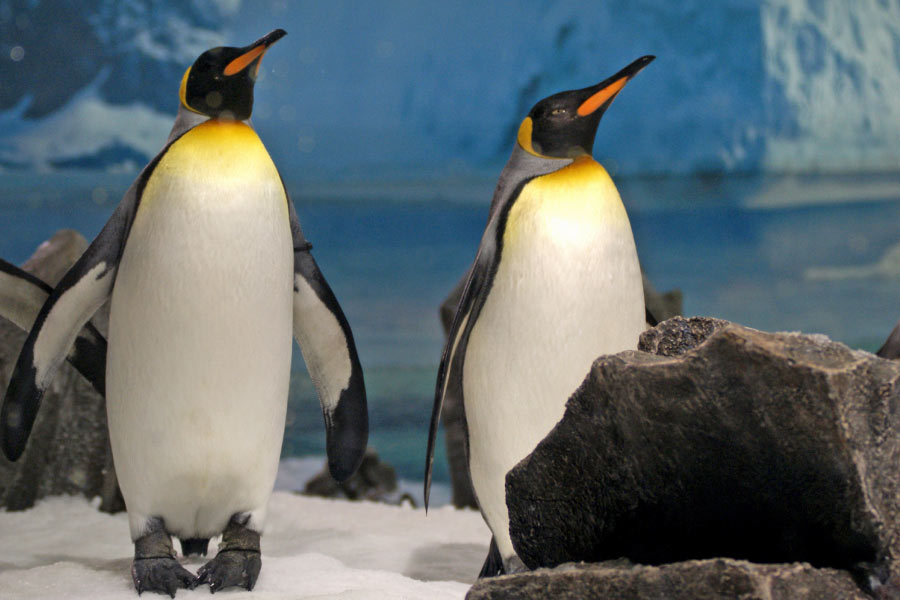
- Scientific name: Aptenodytes patagonicus
- Type: Great Penguin
- Max weight: 18 kg / 40 lb
- Max height: 100 cm / 39 in
- Conservation status: Least Concern
- Population change: Increasing
The king penguin is the world’s second-largest penguin species (only the closely-related emperor penguin is larger). Like the emperor penguin, it has a white chest that is orange-yellow towards the neck. The king penguin has bright orange ‘ear patches’.
The king penguin is found in several Antarctic and sub-Antarctic locations, including the Falkland, Crozet and Prince Edward Island groups, Tierra del Fuego and the continent of Antarctica itself.
Little Penguin
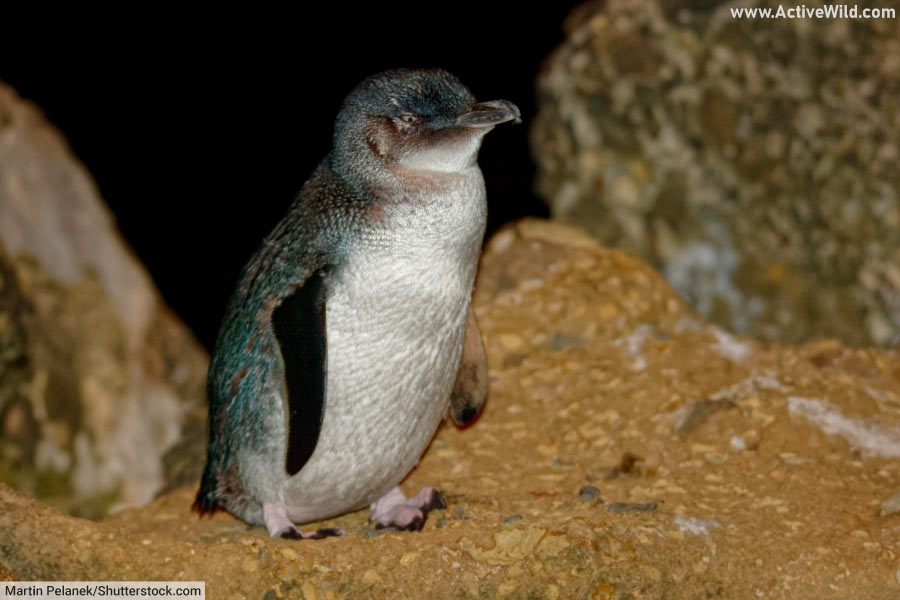
- Other names: Australian little penguin / fairy penguin / white-flippered penguin
- Scientific name: Eudyptula minor
- Type: Little Penguin
- Max weight: 1.5 kg / 3.3 lb
- Max height: 33 cm / 13 in
- Conservation status: Least Concern
- Population change: Stable
Standing at around 30 cm (12 in.) tall, the little penguin is the world’s smallest species of penguin.
The species can be identified by its small size, dark bill, and the blue tinge of its plumage.
Little penguins are found in New Zealand (where they are also known as little blue penguins), and Australia (where they are also known as fairy penguins).
As with the rockhopper penguin, there is some disagreement over exactly how many species of little penguin there are. Three very similar types of little penguin exist (little penguin, Australian little penguin and white-flippered penguin). Some scientists consider all three to be subspecies of the little penguin; others consider them to be either two or three separate species.
The Australian little penguin is mainly found on islands lying off the southern coast of Australia. There are also breeding grounds on the mainland.
The white-flippered penguin has white markings on its flippers. It is found on the Banks Peninsula of New Zealand’s South Island, and on Motunau Island, a nature reserve that lies off the coast of South Island.
- You can find out more about the little penguin on this page: Little Penguin Facts
Macaroni Penguin
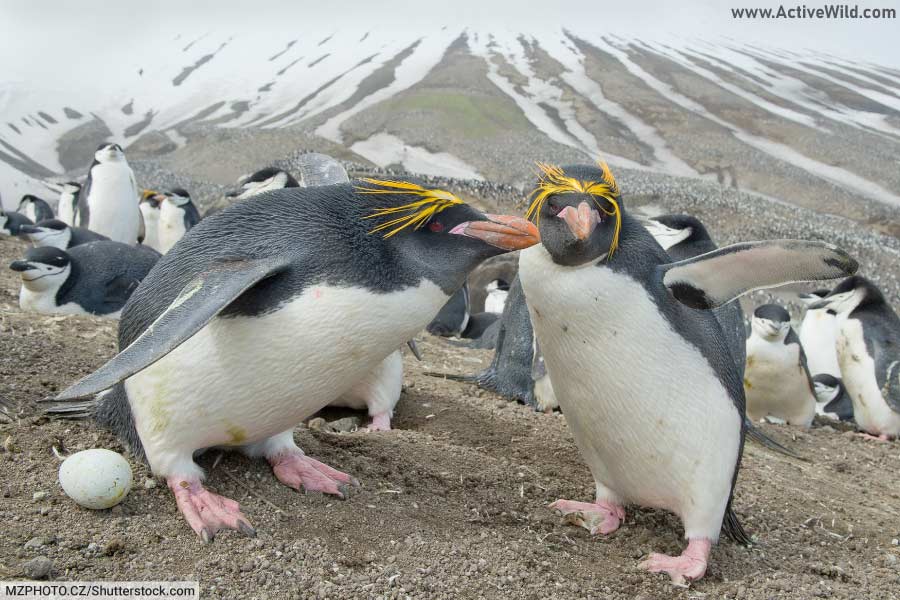
- Scientific name: Eudyptes chrysolophus
- Type: Crested Penguin
- Max weight: 6.4 kg / 14 lb
- Max height: 71 cm / 28 in
- Conservation status: Vulnerable
- Population change: Decreasing
The macaroni penguin has a yellow crest, a black face and red bill. The species was named by English sailors; the penguin’s bright yellow crest reminded them of ‘macaronis’ – followers of an 18th century fashion in which men wore large wigs and flamboyant clothing.
The Macaroni penguin is found in several locations in the Indian and South Atlantic Oceans, including the Crozet, Kerguelen, Heard, South Georgia and Prince Edward Island groups.
The Macaroni penguin is the world’s most common penguin, with a global population of around 6.3 million breeding pairs. Despite its relative abundance, the species’ conservation status is ‘vulnerable’ due to a sharp population decline that has taken place over the last 30-50 years.
Magellanic Penguin
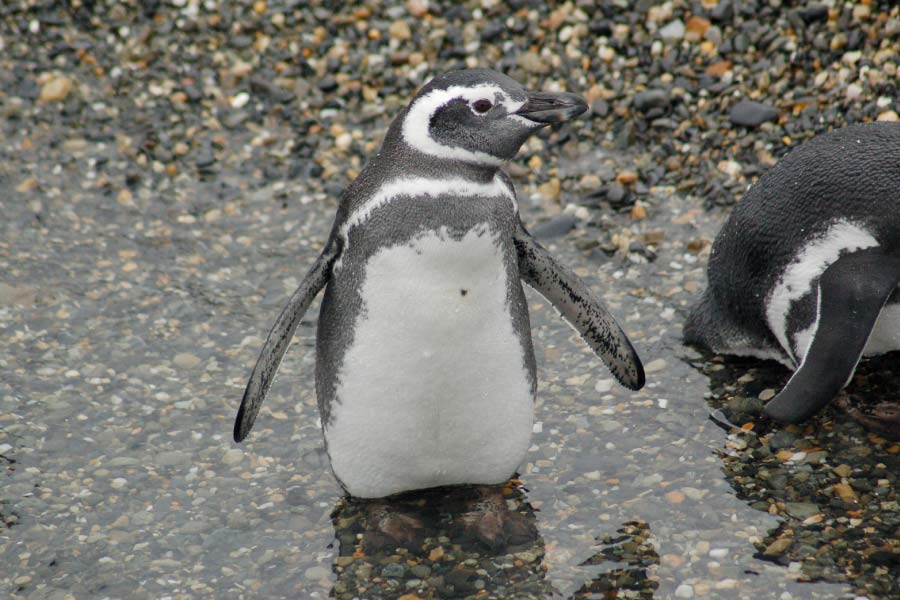
- Scientific name: Spheniscus magellanicus
- Type: Banded Penguin
- Max weight: 6.5 kg / 14.3 lb
- Max height: 76 cm / 30 in
- Conservation status: Least Concern
- Population change: Decreasing
The Magellanic penguin is the most common banded penguin. It is a medium-large penguin with a black band running across its white chest and under its wings. Its face is black with a white border.
The species breeds on the Pacific and Atlantic coasts of southern South America and on the Falkland Islands. During the winter it migrates as far north as northern Brazil.
The Magellanic penguin was named after Portuguese explorer Ferdinand Magellan. It was discovered during Magellan's 1519 expedition to reach the East Indies via the Pacific Ocean. (Although Magellan was killed during the expedition, one of its ships returned to Spain in 1522 under the command of navigator Juan Sebastián Elcano. It was the first ever circumnavigation of the Earth.)
Northern Rockhopper Penguin
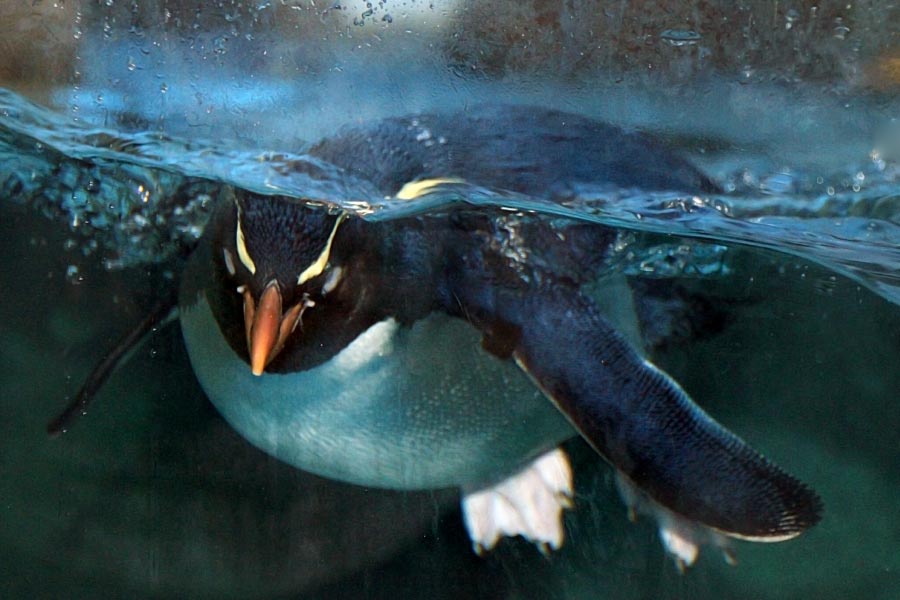
- Other names: Moseley's rockhopper penguin
- Scientific name: Eudyptes moseleyi
- Type: Crested Penguin
- Max weight: 4.5 kg / 10 lb
- Max height: 56 cm / 22 in
- Conservation status: Endangered
- Population change: Decreasing
Although similar in appearance to the closely-related southern rockhopper, the northern rockhopper has longer yellow plumes and a wider supercilium (eye-stripe).
The northern rockhopper penguin is found further north than its southern counterpart. 85% (or more) of the world’s northern rockhoppers are found on the islands of the Tristan da Cunha archipelago and Gough Island in the Atlantic Ocean.
The world population of northern rockhopper penguins has declined by 90% since the 1950’s, and the species is now endangered.
Royal Penguin
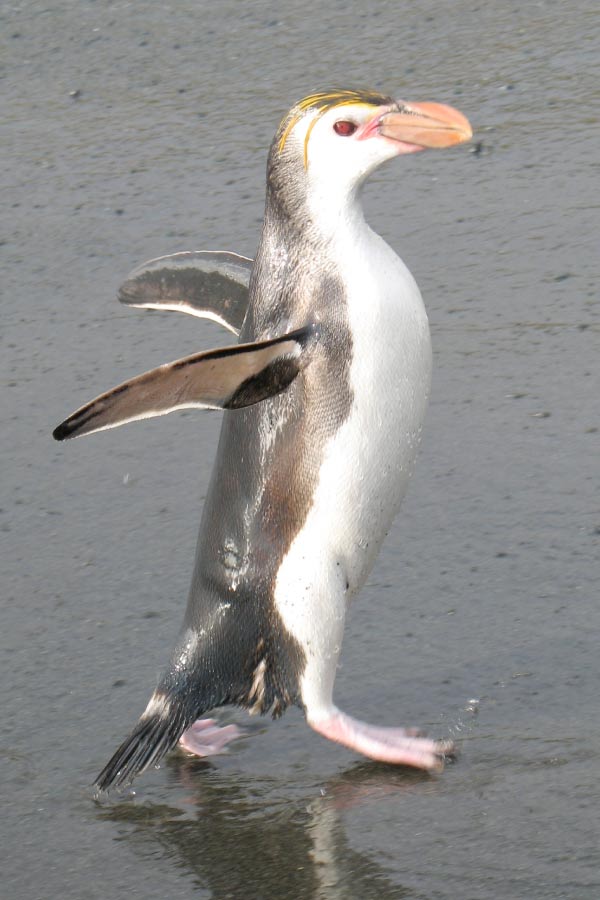
- Scientific name: Eudyptes schlegeli
- Type: Crested Penguin
- Max weight: 8 kg / 17.6 lb
- Max height: 76 cm / 30 in
- Conservation status: Least Concern
- Population change: Stable
The royal penguin is very closely related to the macaroni penguin. The main physical difference between the two birds is the royal penguin's white face. So closely-related are the two species that many scientists consider them to be the same species.
The royal penguin is found on Macquarie Island (an Australian island in the Pacific Ocean) and surrounding islands.
Snares Penguin
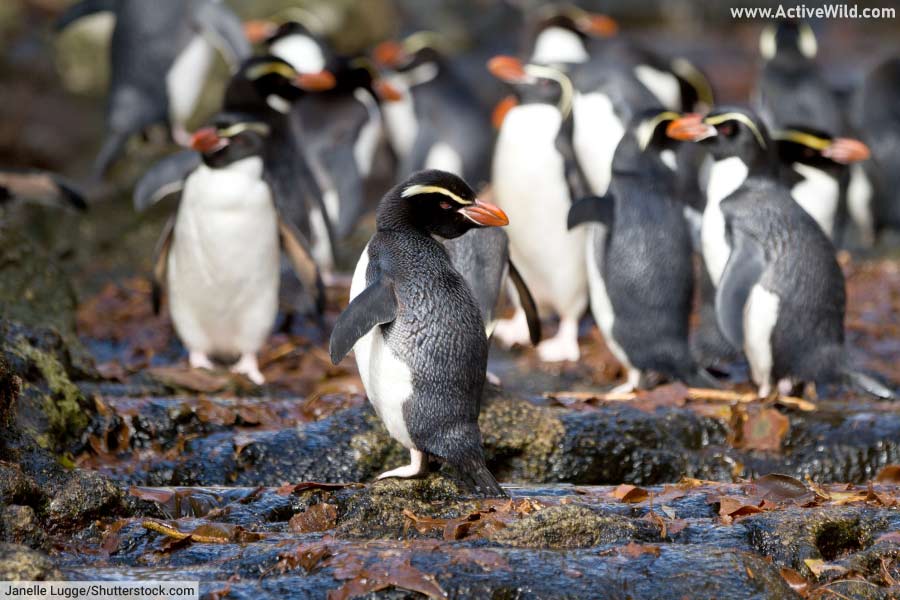
- Scientific name: Eudyptes robustus
- Type: Crested Penguin
- Max weight: 4 kg / 8.82 lb
- Max height: 70 cm / 27.5 in
- Conservation status: Vulnerable
- Population change: Stable
Snares penguin is a species of crested penguin that breeds on (and is named after) The Snares, a group of islands that lie 124 miles / 200 km south of New Zealand’s South Island.
Outside of the breeding season, the Snares penguin forages over a wide area, including the Tasman Sea and the eastern Indian Ocean.
The Snares penguin has a yellow eyebrow-crest and a heavy, orange-red bill. At the base of the bill is an area of bare, pink-colored skin.
Southern Rockhopper Penguin
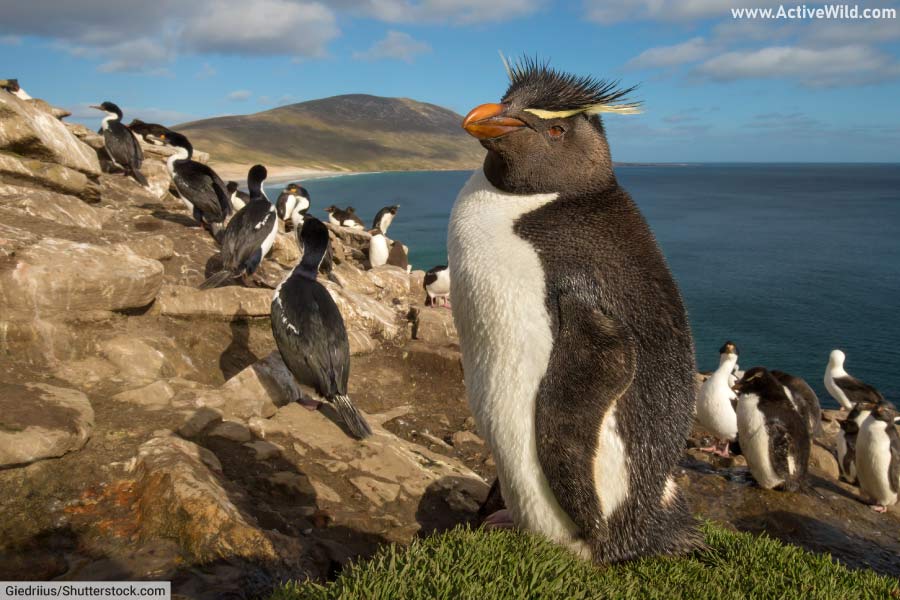
- Scientific name: Eudyptes chrysocome
- Type: Crested Penguin
- Max weight: 3.4 kg / 7.5 lb
- Max height: 58 cm / 23 in
- Conservation status: Vulnerable
- Population change: Decreasing
Like all rockhopper penguins, the southern rockhopper penguin is a relatively small penguin with red eyes, orange beak, spiky black head feathers, yellow eyebrows and a yellow crest.
Rockhopper penguins are found on various south Atlantic and Indian Ocean island groups, including Tristan de Cunha, the coastlines of Argentina and Chile, and on Campbell Island in New Zealand.
The southern rockhopper is found on several islands in the South Atlantic, Indian and Pacific Oceans. As its name suggests, it is found further south than the northern variety.
The southern rockhopper penguin has a narrower supercilium (the stripe of yellow over its eyes) and shorter yellow plumes than the northern rockhopper.
So closely-related are the rockhopper penguins that some biologists consider them all to be subspecies of the same species.
Yellow-Eyed Penguin
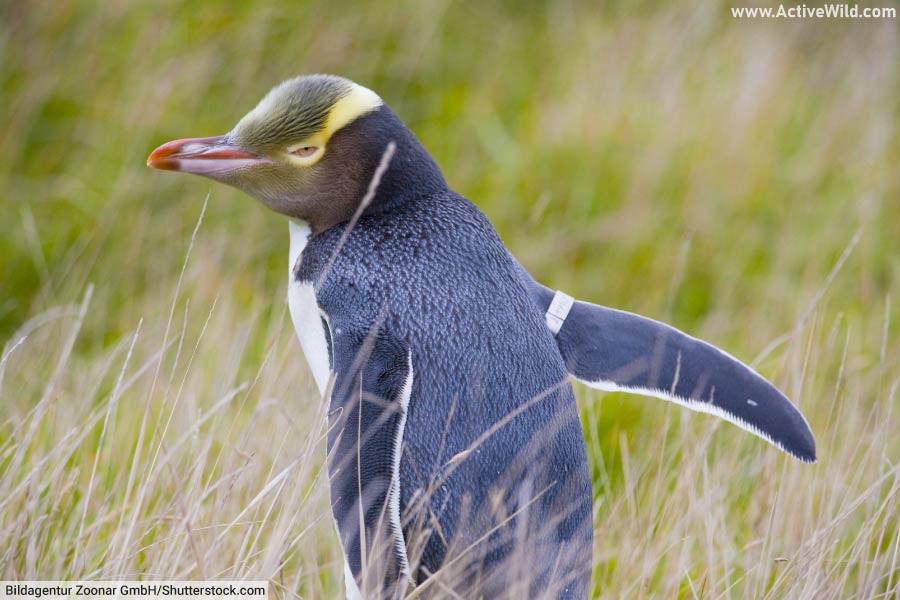
- Scientific name: Megadyptes antipodes
- Type: Yellow-Eyed Penguin
- Max weight: 8 kg / 18 lb
- Max height: 79 cm / 31 in
- Conservation status: Endangered
- Population change: Decreasing
The yellow-eyed penguin is the fourth-largest penguin, and the largest that breeds on mainland New Zealand. As its name suggests, it has yellow eyes. Other distinguishing features include a yellow band that runs from eye to eye behind the head and an orange-pink bill and feet.
The species is found on the coast of New Zealand’s South Island and also on the Auckland and Campbell Islands.
With a declining global population that currently numbers just 2,600 to 3,000 mature individuals, the yellow-eyed penguin is an endangered species.
One of the main factors in the yellow-eyed penguin's endangered status is commercial gillnetting. Although the penguin is not specifically targeted, it is caught accidentally as bycatch.
Penguin Species Chart
The chart below contains all 19 penguin species that are currently recognized by the IUCN. Click on the title row to sort the chart.
| Penguin Species | Scientific Name | Type Of Penguin | Max. Weight (lb) | Max Height (in) | Conservation Status |
|---|---|---|---|---|---|
| Adélie Penguin | Pygoscelis adeliae | Brush-Tailed Penguin | 13.2 | 28 | Least Concern |
| African Penguin | Spheniscus demersus | Banded Penguin | 7.7 | 28 | Endangered |
| Chinstrap Penguin | Pygoscelis antarctica | Brush-Tailed Penguin | 11 | 28 | Least Concern |
| Eastern Rockhopper Penguin | Eudyptes filholi | Crested Penguin | 10 | 22 | Unassessed |
| Emperor Penguin | Aptenodytes forsteri | Great Penguin | 100 | 51 | Near Threatened |
| Erect-Crested Penguin | Eudyptes sclateri | Crested Penguin | 13.2 | 28 | Endangered |
| Fiordland Penguin | Eudyptes pachyrynchus | Crested Penguin | 13.1 | 24 | Near Threatened |
| Galápagos Penguin | Spheniscus mendiculus | Banded Penguin | 5.5 | 19 | Endangered |
| Gentoo Penguin | Pygoscelis papua | Brush-Tailed Penguin | 19 | 35 | Least Concern |
| Humboldt Penguin | Spheniscus humboldti | Banded Penguin | 13 | 28 | Vulnerable |
| King Penguin | Aptenodytes patagonicus | Great Penguin | 40 | 39 | Least Concern |
| Little Penguin | Eudyptula novaehollandiae | Little Penguin | 3.3 | 13 | Least Concern |
| Macaroni Penguin | Eudyptes chrysolophus | Crested Penguin | 14 | 28 | Vulnerable |
| Magellanic Penguin | Spheniscus magellanicus | Banded Penguin | 14.3 | 30 | Least Concern |
| Northern Rockhopper Penguin | Eudyptes moseleyi | Crested Penguin | 10 | 22 | Endangered |
| Royal Penguin | Eudyptes schlegeli | Crested Penguin | 17.6 | 30 | Near Threatened |
| Snares Penguin | Eudyptes robustus | Crested Penguin | 8.82 | 27.5 | Vulnerable |
| Southern Rockhopper Penguin | Eudyptes chrysocome | Crested Penguin | 7.5 | 23 | Vulnerable |
| Yellow-Eyed Penguin | Megadyptes antipodes | Yellow-Eyed Penguin | 18 | 31 | Endangered |
Further Reading
Want to find out more about penguins, birds or the animal kingdom? Check out the following pages!
- You can find out more about penguins here: Penguin Facts
- Are penguins birds? Find out on this page: Are Penguins Birds... And Why?
- Discover which types of penguin live on Antarctica here: Antarctic Penguins
- Become a bird expert! Visit this page: Birds: The Ultimate Guide
- Find out about Antarctica – home to several of the penguin species featured in this list. Antarctica Facts

